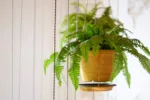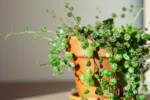The String of Pearls, also known as the Curio Rowleyanus, is a unique trailing succulent vine native to South Africa. It’s a popular houseplant due to its delicate and cascading vines that are adorned with pea-shaped, plump leaves.
Types of String of Pearls
Here are the names of some common types of String of Pearls :
- String of Pearls
- String of Tears
- String of Beads
- Variegated String of Pearls
- Purple String of Beads
- Variegated String of Tears
Benefits of String of Pearls
Air Purification: Like many other houseplants, a string of Pearls enhances interior air quality by producing oxygen during photosynthesis and absorbing carbon dioxide. The string of pearls improves indoor air quality and eliminates contaminants, which helps to purify the air inside buildings.
Stress Reduction: Caring for indoor plants like String of Pearls has been shown to reduce stress and anxiety levels.
Low Maintenance: This succulent is relatively low-maintenance and requires minimal attention to thrive. This plant doesn’t demand much care. It thrives with adequate light and well-drained soil. Fertilizing occasionally can boost its growth
Unique Appearance: The round, bead-like leaves resemble a delicate pearl necklace, adding charm to your space
Propagation Potential: You can propagate the string of pearls through stem cuttings, allowing it to live longer. Regular pruning and propagation help maintain its vitality
Disadvantages of String of Pearls
is a popular and visually appealing plant, but it does have some disadvantages or considerations to keep in mind.
Toxicity: The String of Pearls is toxic for both people and animals. Consumption of any part of the plant may cause vomiting, diarrhea, and other gastrointestinal issues. Don’t let kids or dogs go near it.
Light Requirements: These plants thrive on direct and indirect sunlight which may not be readily available in all indoor environments.
Watering: The biggest problem with the String of Pearls is usually related to too much or too little water.
Common Problems: This plant doesn’t have many serious disease problems, except for problems with water.
String of Pearls caring
Caring for a String of Pearls (Senecio rowleyanus) involves providing the right conditions to ensure its health and longevity. Here are some tips for caring for this unique succulent
Light: Place your String of Pearls in a location with bright, indirect light. Steer clear of sunlight that is direct, particularly throughout the afternoon and evening.
Temperature: String of Pearls prefers temperatures between 65°F to 75°F (18°C to 24°C). Protect the plant from cold drafts and temperatures below 50°F (10°C), as they can damage or kill the plant.
Watering: To avoid root rot, let the soil dry completely in between uses for water.
Soil: Plant your String of Pearls in well-draining soil specifically formulated for succulents or cacti.
Propagation of String of Pearls
Stem cuttings in soil: This is the most common and successful method for String of Pearls propagation.
Select Healthy Plant: Choose a healthy String of Pearls plant with long, trailing stems. Look for stems that are free from signs of damage or disease.
Prepare Cutting: Using clean, sharp scissors or pruning shears, cut a stem or stems from the parent plant. Each cutting should be at least 3-4 inches (7.5-10 cm) long and include several sets of leaves.
Plant Cuttings: Once the cuttings have callused over, prepare a small pot with well-draining soil.
Provide Light and Water: Place the pot in a location with bright, indirect light. Avoid direct sunlight,
Root Development: Over the next few weeks, the cuttings should begin to develop roots. To test for the development of roots, you can gently pull on the cuttings to see if there is any sort of protest.
Repotting of String of Pearls
Choose the Right Time: The best time to repot your String of Pearls is during the spring or early summer months when the plant is actively growing. Repotting should be avoided in the winter’s dormant months.
Gather Supplies: You’ll need a new pot that is slightly larger than the current one, fresh potting soil formulated for succulents, a trowel or spoon for scooping soil, and gloves if desired.
Set Up the New Pot: To stop flooding, verify that the new pot has drainage holes. Add a layer of small rocks or broken pottery pieces to the bottom of the pot to improve drainage.
Remove the Plant: Gently tip the old pot to the side and carefully slide the String of Pearls out, supporting the base of the plant with your hand. If the plant is stubborn, you may need to tap the bottom of the pot or use a trowel to loosen the soil around the edges.
Inspect the Roots: Once the plant is out of the pot, inspect the roots for any signs of rot or damage. Trim away any dead or rotting roots with clean scissors or pruning shears.
Report the Plant: Place a layer of fresh potting soil in the bottom of the new pot. Hold the String of Pearls in the center of the pot and add soil around the sides, gently pressing it down to secure the plant. Ensure the plant is at the same depth as it was in the old pot.
Fill in Soil: Fill in any gaps around the plant with additional soil, leaving about an inch of space between the soil surface and the rim of the pot to allow for watering.
Water Thoroughly: Give the newly repotted String of Pearls a thorough watering to settle the soil and hydrate the roots. Allow Let any extra fluid completely drain away.
String of Pearls of Disease
Root Rot: This is the biggest disease threat to String of Pearls and arises from overwatering
- Gently remove the plant from the pot and inspect the roots.
- Remove any mushy or brown roots with sterilized shears.
- Report the String of Pearls in fresh, well-draining succulent or cactus mix.
- Avoid watering until the plant recovers.
Leggy Growth: Insufficient light can cause String of Pearls to become leggy, with elongated stems and sparse foliage. The plant should be placed in an area with light,
String of Pearls Vastu
Direction: Plants are said to have different energy properties. According to Vastu, flowering plants are generally considered more auspicious and are recommended for the east, north, or northeast directions.
Healthy plants: In Vastu, it is believed that healthy, thriving plants promote positive energy. So, ensure your String of Pearls receives proper care to maintain its health.
String of Pearls for pets
The plant contains compounds that can cause gastrointestinal upset, vomiting, diarrhea, or other adverse reactions in cats, dogs, and other animals if consumed in large quantities
Toxic compounds: The String of Pearls contains saponins and pyrrolizidine alkaloids,
Here are some alternative pet-safe plants that you can consider:
- Spider Plant (Chlorophytum comosum)
- Ponytail Palm (Beaucarnea recurvata)
- Air Plants (Tillandsia spp.)
- Bromeliads (Bromeliaceae family)
- Boston Fern (Nephrolepis exaltata)
How to buy String of Pearls
Online Retailers: Many online retailers and plant shops sell String of Pearls plants and ship them directly to your doorstep. Websites like Etsy, Amazon, and various plant-specific online stores offer a wide range of options to choose from.
Plant Specialty Stores: Look for specialty plant stores or boutique shops that focus on indoor plants. These establishments often offer a diverse selection of houseplants, including String of Pearls.
String of Pearls in other Language
- English: String of Pearls
- Spanish: Collar de Perlas (Senecio rowleyanus)
- French: Collier de Perles (Senecio rowleyanus)
- German: Perlenkette (Senecio rowleyanus)
- Italian: Collana di Perle (Senecio rowleyanus)
- Portuguese: Colar de Pérolas (Senecio rowleyanus)
- Dutch: Ketting van Parels (Senecio rowleyanus)
- Swedish: Pärlhalsband (Senecio rowleyanus)
- Russian: Жемчужное ожерелье (Senecio rowleyanus)
- Japanese: パールの列 (Senecio rowleyanus)
- Chinese (Simplified): 珍珠项链 (Senecio rowleyanus)
- Korean: 진주 목걸이 (Senecio rowleyanus)
- Telugu: పేరలు చేసుకొనుట (“Peralu Chesukonuta”)
- Hindi: मोती का सिरोंज (“Moti Ka Sirohunja”)
- Kannada: ಮೊತ್ತುಗಳ ಸಾಲು (“Mottugala Saalu”)
Conclusion
Caring for a String of Pearls involves providing it with bright, indirect light, well-draining soil, and infrequent watering to prevent root rot. The plant is relatively low-maintenance and can thrive indoors with proper care.
FAQ of String of Pearls
- What are the benefits of having a String of Pearls plant?
Ans: String of pearl plants are great for adding a unique and beautiful touch to your home decor. They are low-maintenance and can thrive indoors with minimal care. - Are there any disadvantages to having a String of Pearls plant?
Ans: Yes, String of Pearls plants can be toxic if ingested, so it’s important to keep them out of reach of pets and small children. Additionally, overwatering or poor drainage can cause root rot. - How do you care for a String of Pearls plant?
Ans: String of pearl plants prefer bright, indirect sunlight and well-draining soil. Water them sparingly, allowing the soil to dry out between waterings. Avoid getting the pearls wet to prevent rot. - How do you propagate a String of Pearls plant?
Ans: A string of pearl plants can be propagated by taking cuttings and placing them in soil or water until roots develop. Simply snip off a healthy strand of pearls and plant it in a new pot with fresh soil. - When should you report a String of Pearls plant?
Ans: Repotting is typically done when the plant outgrows its current pot or when the soil becomes too compacted. This is usually done every 1-2 years in the spring. - What are common diseases that affect String of Pearls plants?
Ans: String of pearl plants are prone to root rot if overwatered. Mealybugs and aphids can also be a problem. Proper care and maintenance can help prevent these issues. - Is there any significance of the String of Pearls in Vastu Shastra?
Ans: In Vastu Shastra, String of Pearls plants are believed to bring positive energy and prosperity into a home. They are often placed in the north or east direction for best results. - Are String of Pearls plants safe for pets?
Ans: No, String of Pearls plants are toxic to pets if ingested. It’s best to keep them in a location where pets cannot access them.


